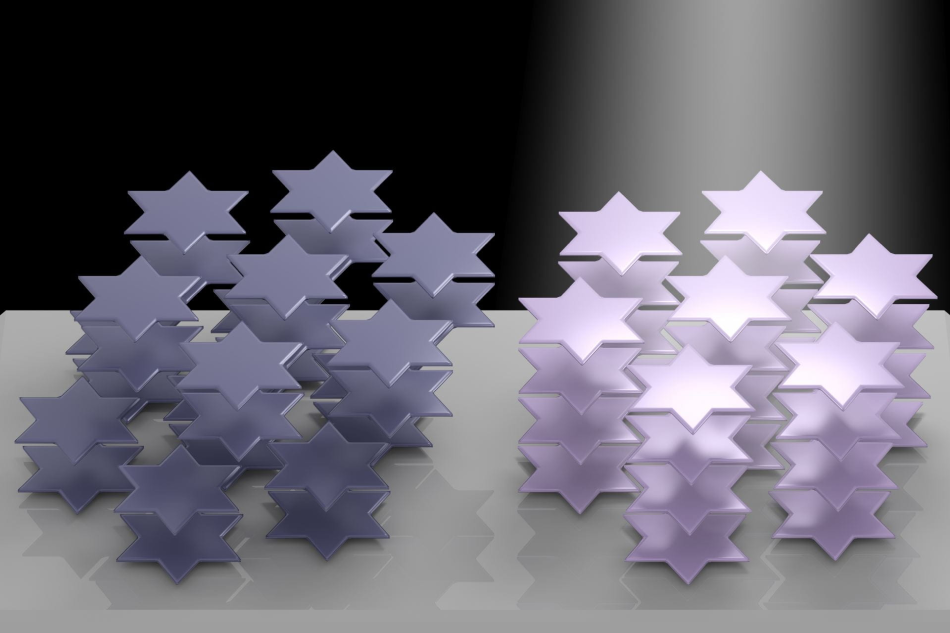Sep 3 2020
Microscopic crystals contained in tantalum disulfide play a crucial role in what could turn into a huge success for virtual reality, three-dimensional (3D) displays, and even self-driving vehicles.
 Atoms in the crystal lattice of tantalum disulfide arrange themselves into six-pointed stars that can be manipulated by light, according to Rice University researchers. The phenomenon can be used to control the material’s refractive index. It could become useful for 3D displays, virtual reality, and in lidar systems for self-driving vehicles. Image Credit: Weijian Li.
Atoms in the crystal lattice of tantalum disulfide arrange themselves into six-pointed stars that can be manipulated by light, according to Rice University researchers. The phenomenon can be used to control the material’s refractive index. It could become useful for 3D displays, virtual reality, and in lidar systems for self-driving vehicles. Image Credit: Weijian Li.
According to engineer Gururaj Naik and graduate student Weijian Li from the Brown School of Engineering at Rice University, a two-dimensional (2D) array of the material possesses distinctive optical features that can be manipulated in ambient settings and under standard illumination.
When the researchers pull a 2D sliver from a bulk sample (with an adhesive tape, which is a proven tool) and direct light on it, the layered material tends to rearrange the charge density waves of electrons that flow through, thereby changing its refractive index. Light radiated along the affected axis alters its color based on the strength of the light that enters.
The discovery has been explained in the Nano Letters journal published by the American Chemical Society.
We need an optical material that can change the refractive index for applications like virtual reality, 3D displays, optical computers and lidar, which is necessary for autonomous vehicles. At the same time, it has to be fast. Only then can we enable these new technologies.
Gururaj Naik, Assistant Professor, Electrical and Computer Engineering, Brown School of Engineering, Rice University
Tantalum disulfide, which is a semiconducting, layered compound that has a prismatic metal center, seems to match the requirement. The material is already proven to include charge density waves at ambient temperature that permit alterations to its electrical conductivity. However, the strength of light input also alters its refractive index, which helps measure the speed at which light travels through. That renders it adjustable, added Naik.
Upon exposure to direct light, the tantalum layer restructures itself into a lattice of 12-atom stars, similar to sheriff’s badges or the Star of David, that enable charge density waves. The type of arrangement of these stars governs whether the compound is metallic or insulating throughout its c-axis.
Furthermore, it has also been found to govern its refractive index. Light activates the stars to realign, thus modifying the charge density waves sufficiently to influence the optical constants of the material.
This belongs to a class of what we call strongly correlated materials, which means the electrons strongly interact with each other. In this case, we can predict the properties that show a strong response to some external stimulus.
Weijian Li, Graduate Student, Brown School of Engineering, Rice University
The fact that the trigger is as mild as ambient white light is a positive aspect, explained Naik. “This is the first material we’ve seen where the interaction of light happens not just with single particles, but with a collection of particles together, at room temperature,” he added.
The novel feature seems to work in tantalum disulfide as thick as 1 mm and as thin as 10 nm, he noted.
We think this is an important discovery for those who study strongly correlated materials for applications. We show light is a very powerful knob to change how correlation extends in this material.
Gururaj Naik, Assistant Professor, Electrical and Computer Engineering, Brown School of Engineering, Rice University
Journal Reference:
Li, W & Naik, G V (2020) Large Optical Tunability from Charge Density Waves in 1T-TaS2 under Incoherent Illumination. Nano Letters. doi.org/10.1021/acs.nanolett.0c02234.